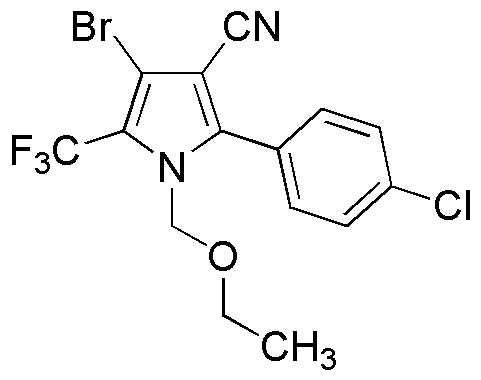Chlorfenapyr is widely utilized in research focused on:
- Agricultural Pest Control: This chemical is primarily used as an insecticide, effectively targeting a wide range of pests in crops such as cotton, soybeans, and vegetables, helping farmers protect their yields.
- Public Health Initiatives: Chlorfenapyr is employed in vector control programs to manage mosquito populations, reducing the spread of diseases like malaria and dengue fever, which is crucial for public health.
- Integrated Pest Management (IPM): It plays a significant role in IPM strategies, allowing for sustainable pest management by minimizing chemical use and promoting environmental safety.
- Termite Control: The compound is effective in controlling termite infestations in residential and commercial buildings, providing long-lasting protection against structural damage.
- Research and Development: Scientists utilize chlorfenapyr in studies to develop new formulations and improve pest resistance management, contributing to the advancement of agricultural practices.
General Information
Properties
Safety and Regulations
Applications
Chlorfenapyr is widely utilized in research focused on:
- Agricultural Pest Control: This chemical is primarily used as an insecticide, effectively targeting a wide range of pests in crops such as cotton, soybeans, and vegetables, helping farmers protect their yields.
- Public Health Initiatives: Chlorfenapyr is employed in vector control programs to manage mosquito populations, reducing the spread of diseases like malaria and dengue fever, which is crucial for public health.
- Integrated Pest Management (IPM): It plays a significant role in IPM strategies, allowing for sustainable pest management by minimizing chemical use and promoting environmental safety.
- Termite Control: The compound is effective in controlling termite infestations in residential and commercial buildings, providing long-lasting protection against structural damage.
- Research and Development: Scientists utilize chlorfenapyr in studies to develop new formulations and improve pest resistance management, contributing to the advancement of agricultural practices.
Documents
Safety Data Sheets (SDS)
The SDS provides comprehensive safety information on handling, storage, and disposal of the product.
Product Specification (PS)
The PS provides a comprehensive breakdown of the product’s properties, including chemical composition, physical state, purity, and storage requirements. It also details acceptable quality ranges and the product's intended applications.
Certificates of Analysis (COA)
Search for Certificates of Analysis (COA) by entering the products Lot Number. Lot and Batch Numbers can be found on a product’s label following the words ‘Lot’ or ‘Batch’.
*Catalog Number
*Lot Number
Certificates Of Origin (COO)
This COO confirms the country where the product was manufactured, and also details the materials and components used in it and whether it is derived from natural, synthetic, or other specific sources. This certificate may be required for customs, trade, and regulatory compliance.
*Catalog Number
*Lot Number
Safety Data Sheets (SDS)
The SDS provides comprehensive safety information on handling, storage, and disposal of the product.
DownloadProduct Specification (PS)
The PS provides a comprehensive breakdown of the product’s properties, including chemical composition, physical state, purity, and storage requirements. It also details acceptable quality ranges and the product's intended applications.
DownloadCertificates of Analysis (COA)
Search for Certificates of Analysis (COA) by entering the products Lot Number. Lot and Batch Numbers can be found on a product’s label following the words ‘Lot’ or ‘Batch’.
*Catalog Number
*Lot Number
Certificates Of Origin (COO)
This COO confirms the country where the product was manufactured, and also details the materials and components used in it and whether it is derived from natural, synthetic, or other specific sources. This certificate may be required for customs, trade, and regulatory compliance.


